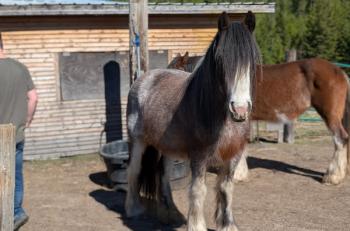
More than 4,500 horses, other animals quarantined in vesicular stomatitis outbreak
While early cases of vesicular stomatitis in Texas sputtered out last month, new cases and quarantines in Colorado were still erupting.
An outbreak of vesicular stomatitis virus (VSV) has forced the quarantine of more than 330 locations in Colorado and Texas, according to the U.S. Department of Agriculture's Animal Health and Plant Inspection Service. More than 4,500 animals are at risk, with 312 showing signs as of Sept. 10.
While cases of animals with clinical signs of the disease are petering out in Texas-27 premises had seen quarantined at press time-new cases in Colorado continued to pop up. Colorado State Veterinarian Keith Roehr, DVM, warned veterinarians and horse owners that all disease vectors-mechanical transmission, insect and livestock movement-need to be contained.
There are no USDA-approved vaccines. Veterinarians and livestock owners who suspect an animal might be infected should immediately contact their state or federal animal health authorities. Livestock with clinical signs of vesicular stomatitis can then be isolated until they're healed and no further threat to other uninfected animals.
“The number of quarantined premises is actually going down in some counties as horses are healing and the quarantines are released,” Roehr says. “[But] we continue to see new cases, so continue to ramp up your fly control.”
The State Veterinarian's Office is also tracking reports of horse owners who have moved horses out of quarantined facilities. Those horse owners can expect citations for violations and fines, according to Roehr.
Livestock shows, however, have not been canceled in Colorado. “The State Veterinarian's Office is not recommending [they] be canceled,” Roehr says. “It is more important to consider certificates of veterinary inspection prior to or on site observations at entry into events and then [employ] insect control measures before, during and after events.”
The disease can be painful for animals and costly for owners. Afflicted animals experience vesicles, erosions and sloughing of the skin on the muzzle, tongue, ears, teats, groin area, and above the hooves. Horses, mules, cattle, bison, sheep, goats, pigs and camelids are all susceptible.
There is a very small risk of zoonotic infection with the disease. In rare cases, humans who handle infected horses can contract vesicular stomatitis and see flu-like symptoms and, on rare occasions, lesions or blisters.
Roehr also reiterated veterinarians' legal duty to report clinical signs of the disease as well as what practitioners could expect when the state or federal foreign animal disease diagnostician (FADD) finally does comes calling. When the virus is suspected, the FADD will gather epidemiological information, take blood samples, collect fluid or tissue from the lesions and take time to inform the reporting veterinarian and the animal's owner on biosecurity and transportation restrictions.
Newsletter
From exam room tips to practice management insights, get trusted veterinary news delivered straight to your inbox—subscribe to dvm360.






